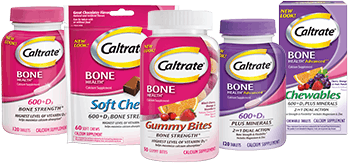CALCIUM & VITAMIN D: SUPPORTING YOUR BONE HEALTH
Vitamin D helps your body maximize calcium absorption*, so you’re getting the most out of your healthy habits every day.
Where do you get these nutrients?
Vitamin D is found in a limited number of foods, such as eggs and certain types of seafood. Your body also produces vitamin D in response to sun exposure. Calcium is found in foods like milk, leafy green vegetables, and soybeans.
How your body uses calcium:
Your body uses calcium every day for activities such as muscle contraction, blood clotting, and nerve function, so it's essential to your bones and your overall health. Your bones act almost like a calcium reserve, because calcium is stored there. When your body isn't getting enough calcium, it may take the necessary amount from the ‘reserve’ in your bones, weakening them and making them more brittle.
This ‘reserve’ of calcium is built up in our bones efficiently until we are about 30 years old. So when our bodies leech calcium from our bones after the age of 30, our bone mass is especially susceptible to decline—and continues to do so as we get older.
This effect is compounded even further during menopause, when a decrease in estrogen levels accelerates bone loss due to bone resorption.
Maintaining good bone health:
Scientific studies have shown that regular exercise and a calcium-rich diet can help build and maintain good bone health and may reduce the risk of osteoporosis later on in life. It's important to maintain a diet with enough calcium and vitamin D, together with other important bone-healthy nutrients, including phosphorus and magnesium.
Currently, more than 81% of American women do not consume the recommended amount of calcium to help maintain healthy bones. The Surgeon General also notes that many people, especially elderly individuals, don't get enough vitamin D from sunlight and diet alone. Foods such as fortified milk contain about 100 IUs of vitamin D, while Caltrate offers several formulas that contain 800 IUs per tablet to nourish your bones.*
Key Points
- It's important throughout all stages of life to maintain a diet with enough calcium and vitamin D. This helps build strong bones early on, maintains strength, and helps to reduce the risk of osteoporosis later in life.
- After your mid-30s, you begin to slowly lose bone mass. Once you've reached the age of 30 adequate and even increased levels of calcium and vitamin D are necessary to maintain bone health.
- Menopausal and post-menopausal women are at an increased risk for a decline in bone mass. Taking Caltrate as a source of calcium and vitamin D3 in conjunction with a healthy diet and exercise may help reduce the risk of osteoporosis. Consult your physician for information about your health needs.
Chart: U.S. Department of Health and Human Services
The 2004 Surgeon General’s Report on Bone Health and Osteoporosis:
“What It Means to You.” U.S. Department of Health and Human Services, Office of the Surgeon General, 2004



